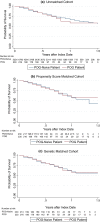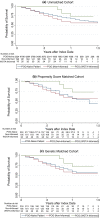Matching methods in precision oncology: An introduction and illustrative example
- PMID: 33237632
- PMCID: PMC7963415
- DOI: 10.1002/mgg3.1554
Matching methods in precision oncology: An introduction and illustrative example
Abstract
Background: Randomized controlled trials (RCTs) are uncommon in precision oncology. We provide an introduction and illustrative example of matching methods for evaluating precision oncology in the absence of RCTs. We focus on British Columbia's Personalized OncoGenomics (POG) program, which applies whole-genome and transcriptome analysis (WGTA) to inform advanced cancer care.
Methods: Our cohort comprises 230 POG patients enrolled between 2014 and 2015 and matched POG-naive controls. We generated our matched cohort using 1:1 propensity score matching (PSM) and genetic matching prior to exploring survival differences.
Results: We find that genetic matching outperformed PSM when balancing covariates. In all cohorts, overall survival did not significantly differ across POG and POG-naive patients (p > 0.05). Stratification by WGTA-informed treatment indicated unmatched survival differences. Patients whose WGTA information led to treatment change were at a reduced hazard of death compared to POG-naive controls in all cohorts, with estimated hazard ratios ranging from 0.33 (95% CI: 0.13, 0.81) to 0.41 (95% CI: 0.17, 0.98).
Conclusion: These results signal that clinical effectiveness of precision oncology approaches will depend on rates of genomics-informed treatment change. Our study will guide future evaluations of precision oncology and support reliable effect estimation when RCT data are unavailable.
Keywords: administrative data; genomic sequencing; matching; precision medicine; quasi-experimental methods.
© 2020 The Authors. Molecular Genetics & Genomic Medicine published by Wiley Periodicals LLC.
Conflict of interest statement
Deirdre Weymann, Steven J.M. Jones, Robyn Roscoe, Sophie Sun, Kasmintan A. Schrader, and Marco A. Marra report no conflicts of interest. Janessa Laskin has received honoraria, ad boards, and institutional grant funding from Roche, BI, AstraZeneca, and Takeda. Howard Lim has received honoraria from Eisai, Taiho, Roche, Lilly, Amgen, and Leo and is an investigator on trials with Bayer, BMS, Lilly, Roche, AstraZeneca, and Amgen. Daniel J. Renouf has received research funding and honoraria from Bayer and Roche, as well as travel funding and honoraria from Servier, Celgene, Taiho, and Ipsen. Sophie Sun has received research grant and honoraria funding from AstraZeneca. Stephen Yip is an advisory board member of Roche, Bayer and Pfizer and has received honoraria form Amgen. Dean A. Regier has received travel support from Illumina.
Figures



Similar articles
-
Clinical and cost outcomes following genomics-informed treatment for advanced cancers.Cancer Med. 2021 Aug;10(15):5131-5140. doi: 10.1002/cam4.4076. Epub 2021 Jun 21. Cancer Med. 2021. PMID: 34152087 Free PMC article.
-
Early-stage economic analysis of research-based comprehensive genomic sequencing for advanced cancer care.J Community Genet. 2022 Oct;13(5):523-538. doi: 10.1007/s12687-021-00557-w. Epub 2021 Nov 29. J Community Genet. 2022. PMID: 34843087 Free PMC article.
-
Whole-genome and transcriptome analysis enhances precision cancer treatment options.Ann Oncol. 2022 Sep;33(9):939-949. doi: 10.1016/j.annonc.2022.05.522. Epub 2022 Jun 9. Ann Oncol. 2022. PMID: 35691590
-
The future of cancer treatment using precision oncogenomics.Cold Spring Harb Mol Case Stud. 2018 Apr 2;4(2):a002824. doi: 10.1101/mcs.a002824. Print 2018 Apr. Cold Spring Harb Mol Case Stud. 2018. PMID: 29610395 Free PMC article. Review.
-
Twenty-First Century Precision Medicine in Oncology: Genomic Profiling in Patients With Cancer.Mayo Clin Proc. 2017 Oct;92(10):1583-1591. doi: 10.1016/j.mayocp.2017.08.002. Mayo Clin Proc. 2017. PMID: 28982488 Review.
Cited by
-
A perspective on life-cycle health technology assessment and real-world evidence for precision oncology in Canada.NPJ Precis Oncol. 2022 Oct 25;6(1):76. doi: 10.1038/s41698-022-00316-1. NPJ Precis Oncol. 2022. PMID: 36284134 Free PMC article. Review.
-
Comparing Survival Outcomes for Advanced Cancer Patients Who Received Complex Genomic Profiling Using a Synthetic Control Arm.Target Oncol. 2022 Sep;17(5):539-548. doi: 10.1007/s11523-022-00910-0. Epub 2022 Sep 5. Target Oncol. 2022. PMID: 36063280 Free PMC article.
-
First-Line Genomic Profiling in Previously Untreated Advanced Solid Tumors for Identification of Targeted Therapy Opportunities.JAMA Netw Open. 2023 Jul 3;6(7):e2323336. doi: 10.1001/jamanetworkopen.2023.23336. JAMA Netw Open. 2023. PMID: 37459099 Free PMC article.
-
Outcomes of Medicare-covered diabetes self-management training for cancer survivors with diabetes.J Cancer Surviv. 2025 Apr;19(2):534-544. doi: 10.1007/s11764-023-01487-x. Epub 2023 Nov 24. J Cancer Surviv. 2025. PMID: 37999856
-
Clinical and cost outcomes following genomics-informed treatment for advanced cancers.Cancer Med. 2021 Aug;10(15):5131-5140. doi: 10.1002/cam4.4076. Epub 2021 Jun 21. Cancer Med. 2021. PMID: 34152087 Free PMC article.
References
-
- Abadie, A. , & Imbens, G. W. (2008). On the failure of the bootstrap for matching estimators. Econometrica, 76, 1537–1557.
-
- Akaike, H. (1974). A new look at the statistical model identification. IEEE Transactions on Automatic Control, 19, 716–723.
-
- Austin, P. C. (2009). The relative ability of different propensity score methods to balance measured covariates between treated and untreated subjects in observational studies. Medical Decision Making, 29, 661–677. - PubMed
Publication types
MeSH terms
Grants and funding
LinkOut - more resources
Full Text Sources
Medical
Miscellaneous

